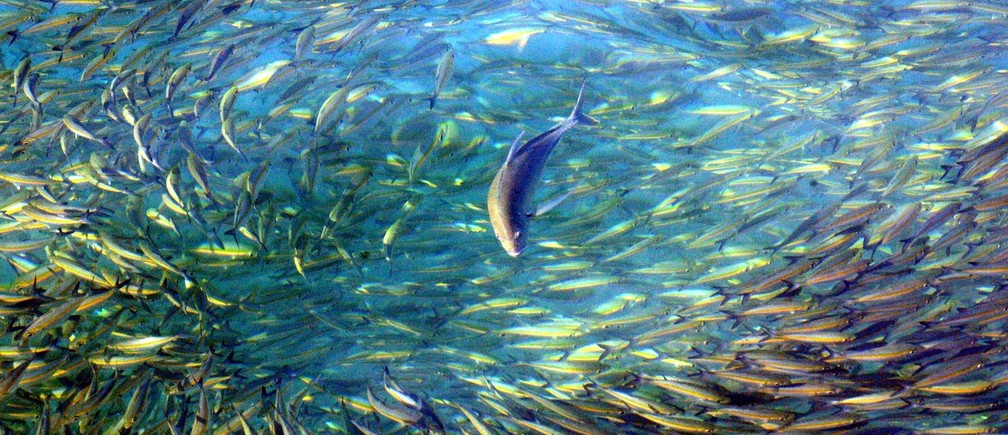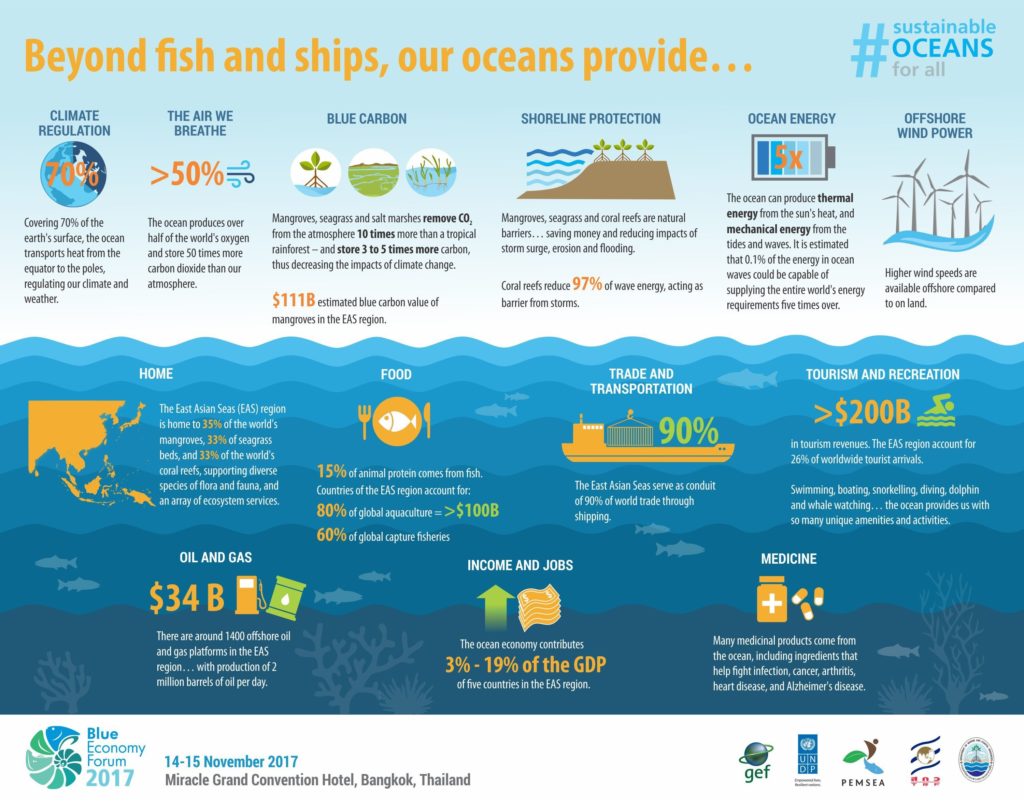
The world’s oceans are running out of breath. In the past 50 years, we have lost nearly half our coral reefs and mangrove forests and the size of marine populations has halved. A third of global fish stocks are already depleted.
If these trends continue, it is estimated that there will be no stocks left for commercial fishing by 2048 in the Asia-Pacific region alone. By 2050, the oceans might contain more plastic than fish by weight and 90% of coral reefs may be lost.
The “blue economy”, which includes livelihoods and other economic benefits derived from oceans, is estimated at between $3 trillion to $6 trillion per year globally. The oceans contribute significantly to the gross domestic product of many developing countries – as much as 13% in Indonesia and 19% in Viet Nam.
Thirty-four million people in the Asia Pacific region are engaged in commercial fishing. In Southeast Asia alone, the export value of the fish caught in 2015 was $19.5 billion. But the cost of overfishing far exceeds this amount. Overfishing reduced the aggregate net benefit of global fisheries by $83 billion in 2012, with two-thirds of this loss occurring in Asia.
A ‘source to sea’ rescue plan
With the future viability of so many economies and livelihoods at stake, saving our blighted oceans is a key development challenge. The declining health of the world’s oceans is an issue that does not just affect a single industry, country or sector; it is a threat to the entire planet and all of its residents. The solution, therefore, must be broad and far-reaching as well.
This involves strategies that cut across multiple sectors and countries of the region in a holistic ‘source to sea’ approach. Governments, NGOs, businesses and other stakeholders all need to do their part. This includes reducing marine pollution at the source while protecting and restoring coastal and marine ecosystems and rivers.
Alternative livelihood and business opportunities need to be created. Port and coastal infrastructure is overdue for modernisation. There is an urgent need for ocean-friendly infrastructure, including integrated solid waste management, ecologically-sensitive port facilities, and municipal and industrial wastewater and effluent treatment. Equally crucial are sustainable agribusinesses that reduce runoff from fertilisers, agrochemicals, waste and soil erosion, as well as a sustainable aquaculture sector.
Attracting the scale of finance needed
The key challenge to implementing these far-reaching solutions is financing. Large-scale investment is required to support these projects and the private sector is the only source with the vast financial resources needed. However, attracting private investors can be tricky for ocean health-related projects.
The private sector needs a return on its investment, which is usually achieved through charges to a ‘user’ base – either a beneficiary or a polluter. As with other global public goods, however, it is often impossible to ascribe direct charges for a project (such as those addressing coastal erosion) given the lack of an identified user base. Moreover, when user charges can be applied, their level is constrained by affordability considerations, such as in municipal wastewater projects. This results in a volatile or at least uncertain revenue model, compromising bankability and constraining the flows of private capital.

‘Blue funds’ have huge potential to help overcome these challenges. Arranged by governments or development finance institutions, they could provide much-needed credit enhancement to projects in the form of ‘blue credits’. These credits are similar to carbon credits, as they provide revenue support based on the value of the avoided costs from undertaking a high-impact project. Such funds could also support issuance by underlying project sponsors of more creditworthy blue bonds to raise competitive long-term capital from the markets.
Multilateral development banks can help by developing blue project selection criteria and policy frameworks, creating financial instruments and products, blue funds or similar financial mechanisms, mobilising concessional finance, and preparing bankable project pipelines.
Green financing has already beaten a path for blue financing to follow. Green instruments aim to pool projects together to diversify risks and enable wider access to financing by tapping the capital markets through green equities and bonds. By enhancing the bankability of a project, these instruments can encourage a scaling up of investments in renewable energy, reforestation, watershed management, air quality and clean transport.
Blue finance investments can make the difference
The Asian Development Bank (ADB) has issued $2.2 billion of Green Bonds since 2010. With additional support, blue investments can be similarly successful. Given the urgency and scale of the problem, these investments need to gain traction rapidly. They are not yet well understood and are currently perceived as slow and risky, so it may take decades to realise, verify, and capitalise on their conservation benefits.
But there is hope that it won’t take that long. Blue funds offer a way to work with governments to improve the risk-return profiles of projects and to structure pooled investment products that can unlock private capital. For blue finance to become mainstream, governments and the general public need to be convinced of the urgency of financing projects that support ocean health. Development partners like ADB can help quantify the real costs and benefits of blue investments for both governments and the private sector. As these benefits are better understood, we expect more willingness to finance the related costs.
The local knowledge of development organisations, as well as their strong relationships with national and municipal governments and other development partners, will be critical to ensuring that the right blue investments are made in the region. This is why ADB has launched a new Action Plan for Healthy Oceans and Sustainable Blue Economies.
Deep-cleaning our oceans is a massive undertaking, and the price tag will be similarly large. Blue finance offers a way to share the funding of these initiatives – but we must act now, while there is still time.
Article Credit: WeForum
